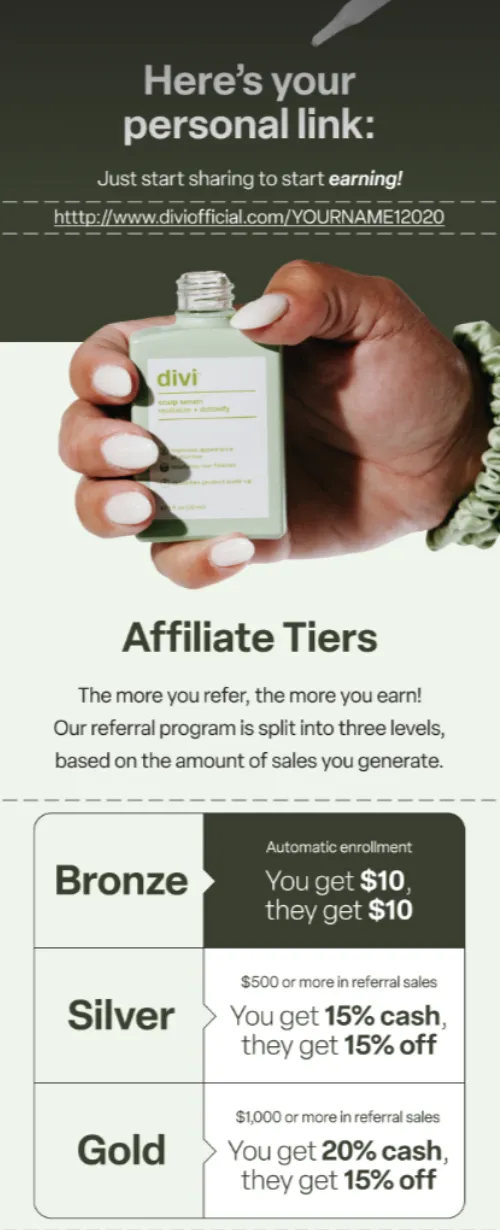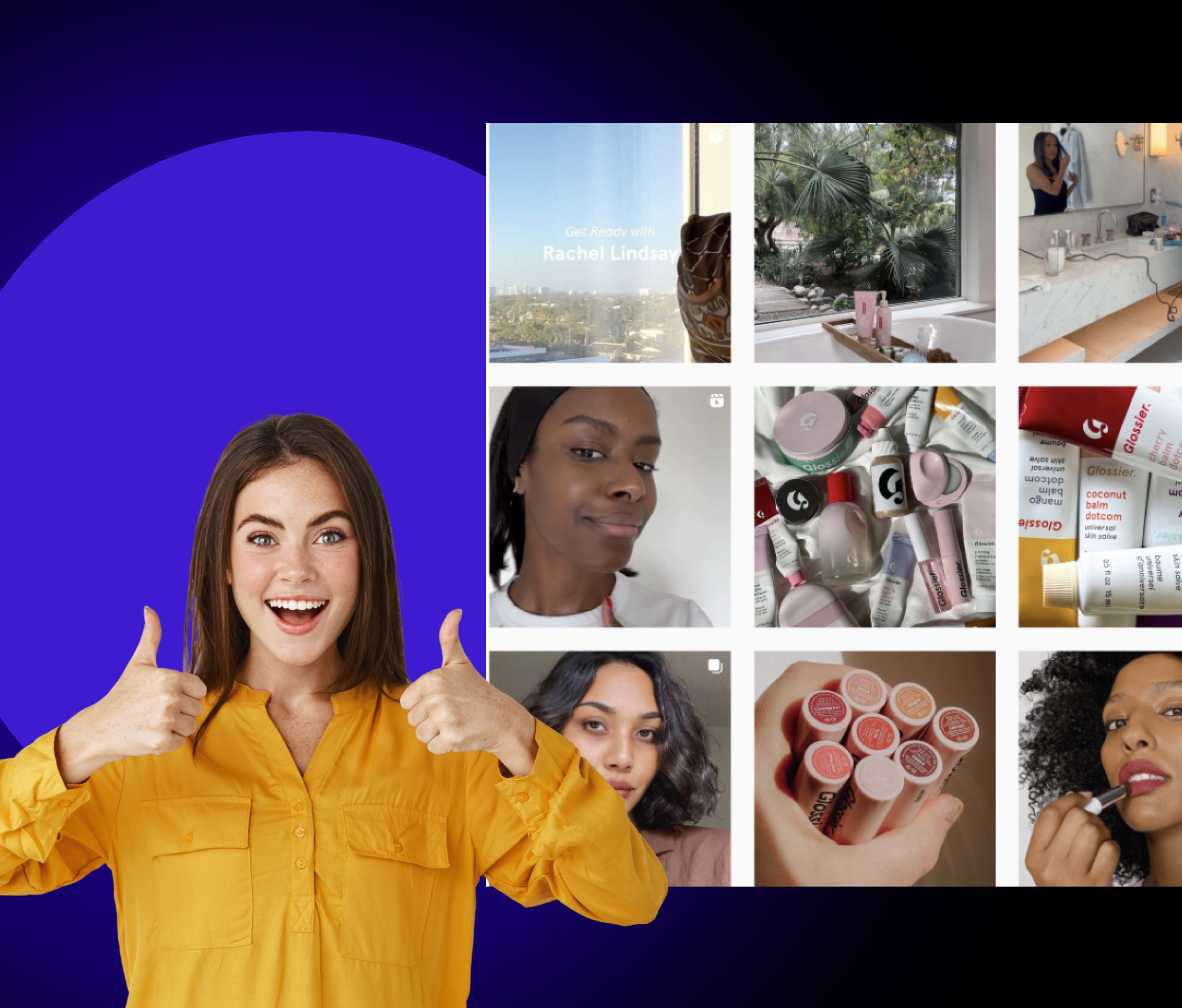Influencer marketing started simple. Brands used to look at follower count and offered flat fees for promoting their products. As the market has evolved and grown, brands now consider more than just follow count while static deals have been replaced with performance-driven partnerships.
The line between influencer and affiliate marketing has blurred now. Influencers still create content that builds trust, but now affiliate systems track and reward that content based on actual sales. The result is a hybrid model where creativity meets performance.
According to the 2025 Affiliate Influencer Benchmark Report, creators with 50–100K followers drive the highest conversion rate (1.3%), while those with 200–500K followers generate the most sales overall. This shows that when reach and relevance meet, revenue follows.
To understand how leading brands are making this blend work, we spoke with:
- Rabii Babou, CEO at Livano Agency
- Jonathan Gosper, President at Evestar
- Jordan West, CEO at Social Commerce Club
They shared tips on how to scale ecommerce campaigns through both creator content and affiliate performance.
Why ecommerce brands are combining influencer and affiliate marketing
Influencer marketing builds awareness, but not accountability. You can pay for reach, engagement, or content volume, but without a way to track conversions, you’re operating on assumptions.
That’s why more ecommerce brands are combining influencer and affiliate models. It gives you visibility into what actually sells and helps you scale creator partnerships based on real performance, not vanity metrics.
Here’s why this approach works:
- Every post becomes measurable: When you track performance using affiliate links or unique discount codes, you can see exactly which creator drove each sale and not just who got the most views.
- Creators stay motivated longer: Instead of a one-time fee, creators earn a commission on every order they bring in. A small flat payment secures the content while performance pay keeps them invested.
- Budgets stretch further: You spend based on results, not guesses. One campaign can run across influencer, affiliate, and paid media channels using the same UGC assets.
“The sweet spot is hybrid deals: flat fee and commission. When the financial upside is tied to sales, campaigns stop being about vanity metrics and start delivering real revenue.”
- Rabii Babou, CEO at Livano Agency
- Data gets unified: With both influencer and affiliate programs tracked together, brands can see real sales lift from creator campaigns. In fact, those using shared creator data across both saw a 32% higher click-to-order conversion year-over-year.
“The power is in hybrid performance models: influencers spark top-funnel buzz, feeding into affiliate tracking for hard sales.”
- Jonathan Gosper, President at Evestar
Common mistakes when running them separately
Most ecommerce teams still run influencer and affiliate marketing as two different tracks: one chasing reach and the other tracking sales. The problem with this is that you end up with scattered data, inflated CAC, and no visibility into what’s actually driving revenue.
When awareness and attribution live in separate systems, your campaigns work harder but perform worse. Here’s what typically goes wrong when influencer and affiliate efforts don’t connect:
Siloed campaigns and disconnected data
When influencer and affiliate data are kept seperately, you lose the full picture. Influencers might be driving purchase intent, but without affiliate tracking, those conversions get credited elsewhere, or not at all.
“Siloing messes up attribution. If influencer lift isn’t tied to affiliate sales, CAC balloons by 30–40%.”
- Jonathan Gosper, President at Evestar
Running both channels on disconnected tools means you can’t identify overlap or scale content that’s already converting. You’re left optimizing based on partial data, which is basically guesswork.
Paying for reach instead of results
Flat influencer deals look clean on paper but rarely translate to ROI. You pay upfront, they post once, and the sales data stops there. Without affiliate tracking, you have no idea which creators actually sell and which ones just generate views.
“The biggest mistake is running influencer campaigns for ‘awareness’ without affiliate tracking. Treating influencer and affiliate marketing as two separate worlds leaves money on the table.”
- Rabii Babou, CEO at Livano Agency
The smartest brands now combine small upfront fees with performance-based commissions. This shifts your budget toward outcomes: rewarding creators who move product and not just content.
Missing out on long-term compounding
One-off influencer campaigns don’t build momentum. You pay once, get a post, and the impact ends there.
When you turn top creators into long-term affiliates, every campaign builds on the last. They know what converts, test smarter angles, and keep driving repeat sales.
The data also compounds. You can refine your best angles, audiences, and content types, instead of starting from zero every time.
How to structure a blended influencer–affiliate program
The best-performing ecommerce brands don’t guess which creators will sell. Instead, they test, track, and scale the ones that do. A strong hybrid program starts small, builds on proof, and turns your best creators into long-term sales partners.
Here is a step-by-step guide on how you can structure and create a blended influencer-affiliate program:
Step 1: Start with gifting and testing
Gifting is your first filter. It gets your product into creators’ hands without large upfront costs and helps you identify who can genuinely drive conversions.
At this point, you’re not looking for the biggest audience, but for conversion efficiency. In fact, creators with 50–100K followers convert best (1.3%), while smaller nano creators (<50K) often deliver the highest-value carts.
When testing, track three things:
- Content quality: Assess if the content looks authentic and aligns with your brand.
- Engagement ratio: Check to see if the audience is commenting, saving, or asking questions about the product.
- Initial conversions: Even 2–3 tracked sales show selling potential.
“Start with gifting, identify who can sell, then move the sellers to affiliate terms and whitelist their best content. Pay for performance, amplify winners, repeat.”
- Jordan West, CEO at Social Commerce Club
Read our blog on ‘How to easily gift products to new affiliates and influencers’ to get started.
Step 2: Transition top influencer partners to affiliate terms
Once a creator proves they can sell, make it official. Move them to affiliate terms with clear commissions and live tracking. This builds trust and keeps them motivated.
Structure it like a growth system, and not a campaign. Some tips to set this up are:
- Tier commissions by performance: Start at 10–12% and increase to 20% once the creator crosses a weekly or monthly GMV threshold.

- Whitelist top videos: Influencer whitelisting lets you run proven creator posts as ads. You’ll scale conversions without reinventing creative.

- Automate payouts: Set up logic to be able to send out instant payments. Creators who get paid fast, post fast.

- Track long-term metrics: Watch repeat customer rate and LTV by creator. These show whether their audience brings sustainable revenue, not one-time spikes.
“Some affiliates can generate views and traffic, but only a few consistently turn that into sales. Track revenue per affiliate, conversion rates, and repeat order value. In affiliate marketing, sales are the ultimate metric.”
- Rabii Babou, CEO at Livano Agency
This is where the hybrid model takes shape. The creator receives predictable earnings while you pay only for verified revenue
Over time, these creators become your best marketing asset, not because they post more often, but because they drive sales every time they do.
Step 3: Use hybrid payouts
The most effective creator programs reward both creativity and performance. Flat fees alone buy content, but commissions drive sales. A hybrid model does both.
Start with a flat fee per creative to cover time and production, then add a 10–15% commission on every sale that content generates. This structure keeps deals fair upfront but still pushes creators to perform.
“A clear hybrid model like flat fee per video + 10–15% commission keeps creators happy up front and motivated long-term.”
- Rabii Babou, CEO at Livano Agency
For larger creators (200K–500K), hybrid payouts have proven to boost results. It was found that this group improved conversion rates by 56% YoY when compensated through mixed models, showing that even macro influencers stay motivated when revenue is on the line.
“Hybrid it: $500–5K flat, 10–20% commission, extra bonuses for >10% conversions. This pushes influencers toward sales via links, while affiliates chase volume.”
- Jonathan Gosper, President at Evestar
At the other end, nano creators (<50K) often generate fewer but higher-value customers, with an average order value of $193. For them, try hybrid offers tied to AOV or bundled commissions. Rewarding quality over volume gets you stronger margins and long-term retention.
“Offer a mix of both. Small flat to get them moving, real upside on commission. That’s why TikTok Shop works. It’s an affiliate’s dream.”
- Jordan West, CEO at Social Commerce Club
Tip: Hybrid models perform best in beauty, wellness, and consumables: categories where repeat orders and trust drive most of the revenue.
Step 4: Automate tracking and payouts
Once you’ve built momentum, manual management becomes the bottleneck. Tracking codes, affiliate dashboards, and delayed payouts slow everything down. Automation fixes that.
Shopify-native tools like Social Snowball let you manage everything from one place: creator tracking, TikTok Shop sync, instant affiliate activation, communication, and automated payouts. You can see GMV per creator, send emails and SMS, approve commissions, and pay them in one click.

Additionally, platforms with real-time attribution and instant payments do more than save time; they keep creators loyal. Fast payouts prove reliability, while synced tracking makes sure every sale is credited accurately.
Measuring what actually drives incremental growth
You can’t call a campaign successful just because it went viral. Real impact shows up in conversions, repeat purchases, and lower CAC, not in likes or reach.
The best way to measure incremental growth is to set a baseline. Compare CAC and ROAD of your paid ads against your hybrid influencer–affiliate campaigns. If total revenue grows faster than your ad spend, that’s a clear sign that your creator program is driving new, profitable customers.
“If CAC drops and blended revenue rises faster than ad spend, your program is adding efficiency beyond ads.”
- Rabii Babou, CEO at Livano Agency
Focus on hard metrics that tie directly to revenue contribution:
- Conversions per creator: Shows who’s actually selling, not just posting.
- Repeat purchase rate: Signals product satisfaction and long-term retention.
- LTV and payback period: Measure the compounding value of each creator’s customers.
- CAC impact: Tracks whether your blended acquisition cost is improving over time.
“Coupon sales, post-level ROAS, branded search lift, and branded search lift: those tell you if it’s working. I care about incremental contribution, not likes.”
- Jordan West, CEO at Social Commerce Club
Evaluating creator impact over time
Once you know which metrics drive revenue, measure them over time. You’ll see a clear pattern: some creators deliver one-time spikes, others keep compounding.
Focus on revenue per creator, repeat customer rate, and profit payback window. The creators who consistently bring in customers with higher LTV and lower CAC are the ones to retain and reward.
When you double down on those partners and offer better commissions, faster payouts, and priority product drops, your program shifts from campaign-based results to steady, predictable revenue growth.
The future of influencer and affiliate marketing
The next phase of creator marketing is built on performance. Brands don’t want reach. Instead, they prioritize measurable sales. The most successful programs will merge influencer creativity with affiliate accountability to drive trackable, repeatable revenue.
Here are some key trends that will drive the future of influencer and affiliate marketing:
Rise of performance-driven creator partnerships
The era of flat-fee sponsorships is ending. You can’t justify spend without clear results, and creators know it too. The new standard is ongoing, tracked partnerships where both sides earn only when sales happen.
Smaller creators are leading this shift. Nano and micro influencers now deliver the highest AOV and conversion efficiency, proving that loyal audiences outperform mass reach.
“The days of blindly paying a 200K-follower influencer $5,000 for a single video are over. Affiliates now have to prove they can sell, not just reach.”
- Rabii Babou, CEO at Livano Agency
These performance-driven relationships make creator marketing sustainable. You build fewer, stronger partnerships that grow your sales every month.
TikTok Shop and social commerce leading the way
TikTok Shop is completely changing the way creators sell. It combines content, checkout, and conversion in one feed. Shoppers discover, trust, and buy, all without leaving the app.
Short-form, shoppable videos now bridge the influencer–affiliate gap better than any other channel. With real-time analytics, native affiliate links, and instant payouts, creators no longer need a separate setup to act like full-fledged performance partners.
“TikTok Shop is the biggest opportunity. It’s the fastest-growing affiliate ecosystem, and consumer trust on the platform is climbing every month.”
- Rabii Babou, CEO at Livano Agency
Smarter, leaner programs built on quality
Top brands are done chasing volume. They’re skipping inflated affiliate lists and instead, focusing on the few creators who consistently deliver profit.
“Once you find high-
performing affiliates, 70% of your focus should be on scaling them. Keep 30% for testing new ones; real growth comes from deepening relationships with proven sellers.”
- Rabii Babou, CEO at Livano Agency
AI and automation now make that focus scalable. You can identify high-ROI creators, forecast revenue potential, and automate payouts in real time. The result is leaner programs that cost less to manage and perform better with every campaign.
Ready to run influencer campaigns that actually convert?
Influencer and affiliate marketing work best when run together. When you combine creator content with affiliate tracking, every post and payout becomes measurable.
Most brands lose efficiency because of a few simple gaps:
- Paying for reach without tracking sales.
- Managing creators and affiliates in separate systems.
- Running one-off campaigns instead of long-term partnerships.
- Delaying payouts that push top performers to other brands.
Each one costs you sales and slows down growth. Social Snowball fixes these leaks by automating how you track, reward, and scale creator performance:
- Real-time tracking: See exactly who drives sales, repeat orders, and the highest AOV.
- Automated payouts: Pay in bulk and instantly; there is no need for spreadsheets or delays.
- TikTok Shop and Shopify integration: Track all creator and affiliate sales in one dashboard.
- Tiered automation: Move high-performers into better commission brackets automatically.











